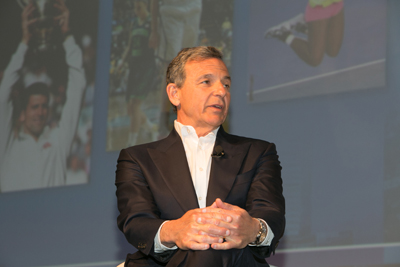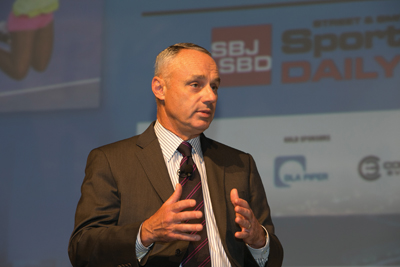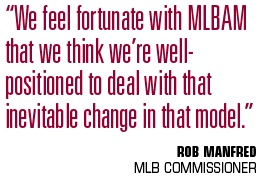The cable TV bundle may be alive, but it’s not well.
Several panelists at the IMG World Congress of Sports in Los Angeles described a cable industry that will have to undergo drastic changes in order to adapt to today’s media world.
“It’s no longer a one-size-fits-all marketplace,” said Walt Disney Chairman and CEO Bob Iger. “That means that not everybody is going to want 100-plus channels for that kind of money. They may want 20 channels. They may want just a package of sports programming or no sports programming. They may even want to buy something just for the day. We have to be prepared to adapt to all of the change that I think is inevitable.”
The cable industry has been losing subscribers over the past couple of years. ESPN is in 94 million homes, according to the most recent estimates from Nielsen. Just four years ago, Nielsen had ESPN in more than 100 million homes. During that time, the cable universe dropped from 105 million homes to 104 million, Nielsen says.
Industry executives expect those numbers to drop further, but they do not think the industry is about to implode. Rather, Iger said, a majority of consumers will continue to see value in subscribing to one big bundle of channels.
 |
Disney Chairman and CEO Bob Iger: “It’s no longer a one-size-fits-all marketplace.”
Photo by: TONY FLOREZ PHOTOGRAPHY
|
“When I’m asked if we’ve seen the end of the bundle, the answer is ‘No. We haven’t,’” he said. “For many people it will still be their primary means of interacting with television. But for many it won’t be, and we have to be prepared to ride that wave or cause that wave.”
To that end, ESPN has been dabbling in disruptive technologies, such as its deal to be part of Dish Network’s Sling TV over-the-top service. Critics believe that ESPN’s involvement in businesses like Sling TV will hasten the demise of the pay-TV bundle. But ESPN President John Skipper said early returns show that most Sling TV customers are millennials who weren’t subscribed to cable anyway.
 |
SKIPPER
|
“We want to buttress the current system while we experiment with other models and other ways to create new revenue streams,” Skipper said. “Over-the-top can just be another delivery system. We’re open for business. When there was cable, we were open for business with satellite. We were open for business for the telephone companies. We’re open for business for the over-the-top services.”
MLB Commissioner Rob Manfred said his league has an interest in supporting the cable industry, especially since many MLB teams have taken equity interests in regional sports networks. But Manfred echoed Iger in saying that the cable industry will have to look a lot different in the near future.
 |
Photo by: TONY FLOREZ PHOTOGRAPHY
|
“Obviously, our clubs — particularly at the local level — have a tremendous amount of money tied up in that cable model and we try to do things that are supportive of that model,” he said. “By the same token, I do understand that that model is going to change and evolve. We feel fortunate with MLBAM that we think we’re well-positioned to deal with that inevitable change in that model.”
Iger also said that Disney is
well-positioned for that change, given the strength of his company’s brands, like ESPN, Marvel, Pixar and Star Wars, that he believes are strong enough to go direct to the consumer.
“What we’ve tried to do as a company is at times be part of the disruption, meaning actually take steps where we could be disrupting the business models that form the underpinning of a lot of our most important businesses,” Iger said. “We feel there’s an inevitability to change, so why not participate in it rather than getting swept over by it?
“Status quo is not a winning strategy for a business today. The world is changing too much. Trying to protect what has today been the staple or the only means that people are getting multichannel TV, there’s a mistake there. We should work hard to continue to put value in that product and to make sure that it is accessible to and a value to as many people as possible, because it’s still a very good value proposition for us, generating a huge amount of money for us.”







